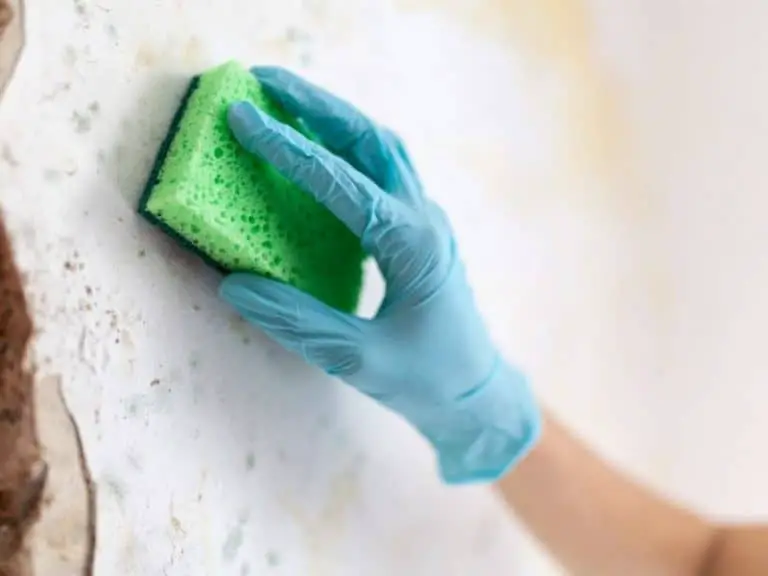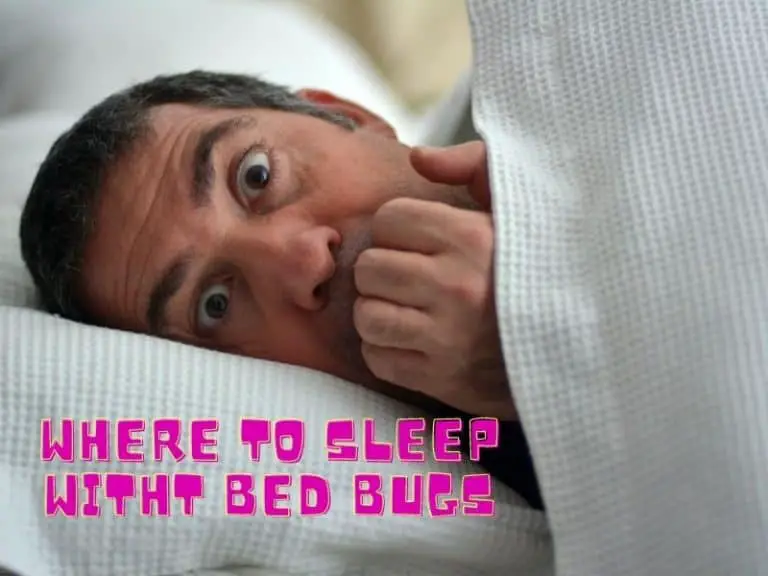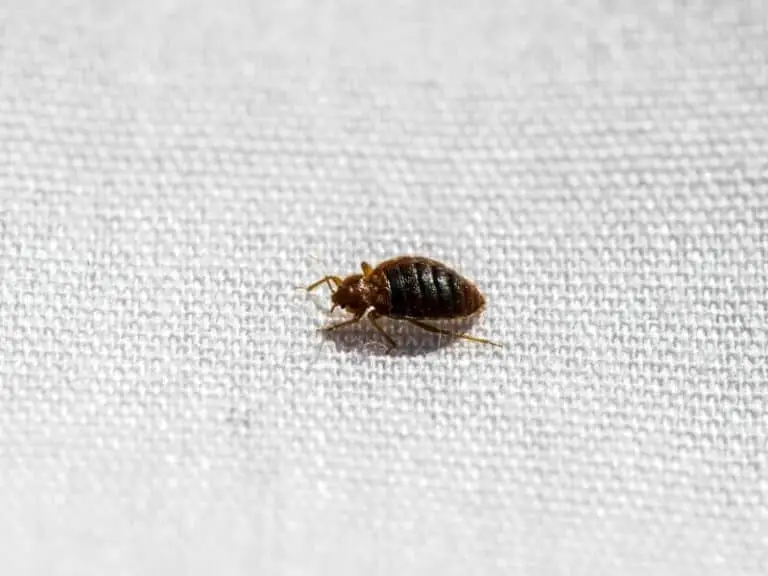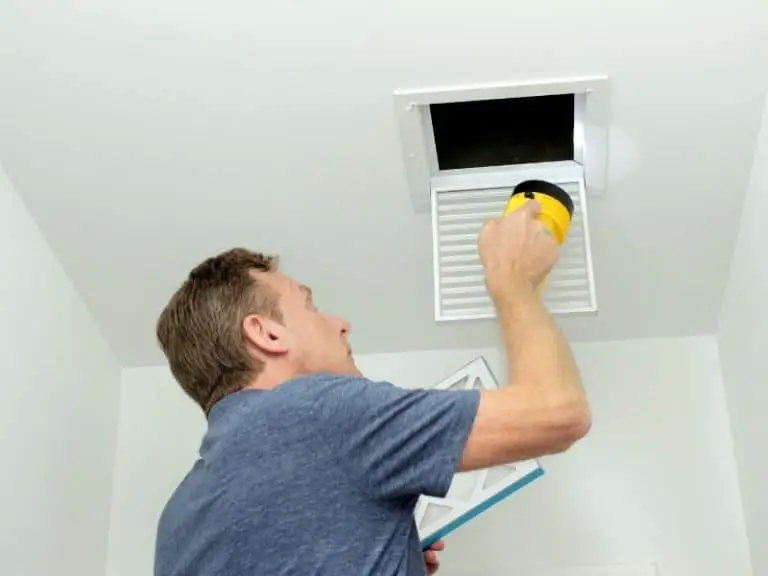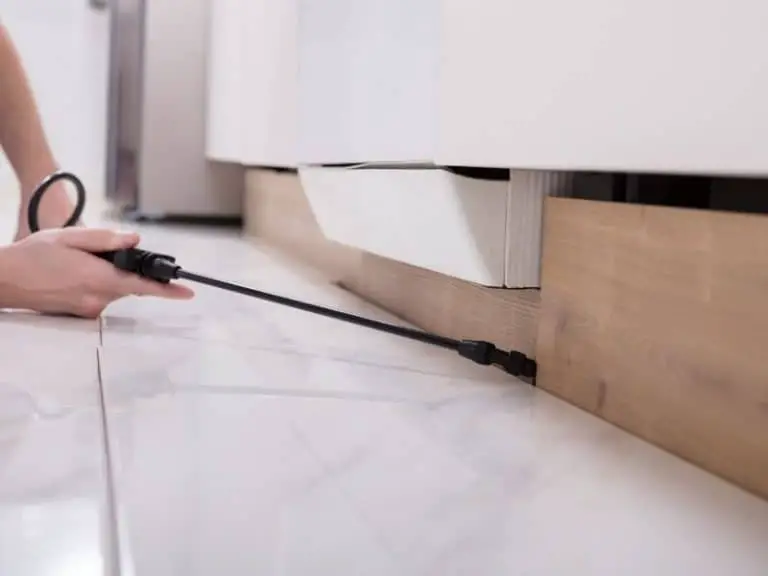How to Get Rid of Bed Bugs: Ultimate 2021 DIY Guide
Plenty of DIY remedies for bed bugs are posted on the internet. Some of them can deliver, while others can’t. Going for those that work is essential if the goal is to put the infestation under control effectively.
DIY bed bug extermination can save up to $4,800. Controlling a bed bug infestation on your own begins with decluttering, washing items in hot water, and setting up double-sided tape traps. Then use rubbing alcohol, diatomaceous earth, and a steam cleaner to exterminate bed bugs in your bed.
Many homeowners prefer to deal with a bed bug infestation without the help of professional pest control companies, as it’s a cheaper option.
Unfortunately, not all home remedies can meet expectations. Those who can, on the other hand, have to be performed in a prescribed order. Otherwise, you may fail to solve the infestation or even make it worse.
Either way, it can leave you with no other choice but to hand over the job to the pros.
Before we check out the complete guide on how to get rid of bed bugs DIY, let us first take a quick look at some of the perks of carrying out home remedies for bed bugs:
- It helps save money — professional bed bug treatment can cost anywhere from $200 to a whopping $4,800, depending on factors such as the infestation’s severity, type of treatment, and your location.
- It eliminates the use of chemicals, many of which can harm the health and the environment.
- It allows you to learn how to deal with bed bugs on your own, and your knowledge and experience may be used to help family members and friends who are in need of help from bed bugs.
- It gives you a potential source of income — you may pursue being an expert in pest control by getting trained or come up with a monetized YouTube channel about getting rid of bed bugs naturally.
Various perks come with dealing with bed bugs through the DIY route. However, it doesn’t mean that home remedies can solve an infestation all the time.
If the bed bug problem is already severe and affects not only your bedroom but also other areas of the home, it is a better idea to get in touch with the pros.
No amount of fix that you can find on the internet or get from someone you personally know can help you with a bed bug infestation that’s out of control.
But if it seems like it is still possible to have the problem solved without the help of the experts, read on!
By the way, check here if you want to know the best bed bug killer powders (safe for humans and pets) on Amazon.com now.
How To Get Rid of Bed Bugs DIY
Various steps may be taken when dealing with a bed bug infestation with your own two hands. However, it is important that you take them in a certain order.
For the most part, it is to prevent bed bugs from hiding elsewhere as well as ending up outside the bedroom to infest other rooms, potentially causing a house-wide problem.
Make sure that you do the following steps as presented if you want to put the infestation to an end successfully.
Declutter Room To Reveal Bed Bug Hiding Places
The very first step to take in your quest to end the infestation is not to eliminate bed bugs but to eliminate clutter. This is done to reveal as many hiding places and give you easy access to them.
However, don’t just transfer clutter to a non-infested room or take it out of the house — this is a complete no-no!
What you need to do is grab some garbage bags and place in them everything that is cluttering up your bedroom. Tie before taking every garbage bag out of ground zero to prevent bed bugs from escaping and starting a colony elsewhere.
Furniture that you wish to remove from the room but are too large to fit in garbage bags may be wrapped in saran wrap.
When inspecting homes and business establishments to assess the problem, pest control experts declutter beforehand. They do so to make it easy to spot hiding places and the bed bugs themselves.
Wash The Bedding
After eliminating clutter, it’s time to remove the bedding, pillowcases, curtains, drapes, and clothes that may be harboring bed bugs out of your room.
Just like with clutter, you should stash them in a garbage bag, which you should securely tie before carrying out of your bedroom. Go straight to where the washing machine is.
Wash and dry them using the hottest possible setting. Experts recommend washing infested items in hot water for at least 30 minutes to be sure.
Other items that you should wash in hot water, if washable, include:
- Pillows
- Throw pillows
- Seat cushions
- Rugs
- Tablecloths
- Wall hangings out of fabric
- Stuffed toys
And speaking of stuffed toys, it is a good idea to throw away those with holes. That’s because some bed bugs may have entered and started a family in them. You should do the same with pillows.
If you cannot throw them away, mend the holes and wash thoroughly in hot water to kill bed bugs inside them.
Stop Bed Bugs Escape With Double-Sided Tape
The moment that you hunt for the potential hiding places of bed bugs and rouse them from their sleep, it is for certain that they will run to safety.
You don’t want this to happen because they may set up camp in uninfested areas of your room. Worse, they may find their way out of your room and reside in another.
Fortunately, you can capture fleeing bed bugs. And it’s something that involves double-sided tape.
Double-sided tape is sticky enough to trap any bed bug that makes the terrible mistake of stepping foot on it.
This is why you should start lining with double-sided tape the box spring, mattress, headboard, legs of the bed and furnishings, baseboard, light switches, cabinets, drawers, electrical outlets, electronic devices, windows, and vents.
To be sure that those pesky bed bugs will be contained in your room, you may also line the door with double-sided tape — you can’t be too careful when it comes to preventing the spread of the infestation!
By the way, some people prefer to smear petroleum jelly on the legs of their beds instead.
Most of them believe that bed bugs don’t like the smell of petroleum jelly, and that’s why they take a U-turn. However, this is not backed by scientific research. It’s likely that bed bugs simply do not want to crawl on any gooey surface.
Spray Rubbing Alcohol and Essential Oils
It was mentioned earlier that you should wash launderable items in hot water. That’s because bed bugs are not very good at tolerating high temperatures, so they die upon coming into contact with hot water.
Well, there is something else that can kill bed bugs on contact. It’s nothing else than rubbing alcohol.
The moment that you see bed bugs sleeping in clusters in cracks or crevices, spray them with rubbing alcohol. Do the same for all bed bug eggs that you encounter elsewhere.
So, in other words, rubbing alcohol is a versatile home remedy for bed bugs as it can kill those bloodsuckers no matter in which life cycle stage they are in.
However, there is one problem with rubbing alcohol: it is highly flammable.
This is why it is not a good idea to rely on rubbing alcohol if the infestation is in an advanced state — you don’t want to risk burning down your home!
Luckily, you may use essential oils instead. Some of those that are proven effective for dealing with bed bugs are:
- Neem
- Lavender
- Lemongrass
- Rosemary
- Clove
- Cinnamon
- Thyme
- Eucalyptus
- Peppermint
- Tea Tree
- Orange
Essential oils can work as either pesticides or repellents. If they are sprayed directly on bed bugs and the eggs, they serve as pesticides — they kill nymphs and adults, and destroy the eggs.
If they are sprayed on potential hiding places, they function as repellents — they drive bed bugs away.
Sprinkle Diatomaceous Earth Powder
Do you come across “diatomaceous earth” a lot of times when searching for effective home remedies for bed bugs online? And are you wondering what this product is?
Here’s what you need to know about diatomaceous earth:
In oceans, rivers, lakes, streams, and other bodies of water, there are algae present called “diatoms.” What’s so interesting about them is that they have shells that resemble glass.
Their shells are rich in silica, which is the second most abundant mineral on the face of the planet. And by the way, it is very good at absorbing water.
This is for the reason why you can find packets of silica in the packaging of products that can be damaged by moisture.
It’s also for the same reason why you can use the content of those packets in killing bed bugs — upon contact, silica absorbs the water in the bodies of bed bugs, leaving them dehydrated and dead.
But why gather tons of packets of silica when you can just get your hands on a container of diatomaceous earth, which is made up of fossilized diatoms?
To use diatomaceous earth in the war against bed bugs, all you have to do is sprinkle it on places where it is likely for bed bugs to hide in or crawl on. You may also sprinkle it generously on upholstery and carpet.
Here’s one of the best and safest powders:
Use a Vacuum Cleaner To Clean Up Remains
Adult bed bugs are the size of an apple seed. However, some of them can be smaller and thus not easy to spot, such as nymphs and those that have been deprived of a blood meal for already a while.
You can always attempt to pick up bed bugs that are in plain sight with your fingers, a pair of tweezers, or tape. Or you can simply take the vacuum cleaner out of storage and start sucking those bloodsuckers all at once.
A vacuum cleaner can also come in handy when it comes to catching bed bugs in their hiding places and hard-to-reach areas.
Vacuum the mattress, box spring, headboard, furniture, upholstery, vents, electrical outlets, switch plates, and baseboard thoroughly.
It is also a good idea to vacuum large electronics, such as a TV set and a computer, as the screw holes, ports, and other openings in them may be harboring bed bugs.
Bed bugs may find solace in carpets, too. This is especially true if the kind installed in your room is thick or shaggy.
Needless to say, you should also vacuum your carpet. Consider sprinkling generous amounts of diatomaceous earth on the carpet before vacuuming it.
Just a word of advice: The best vacuum cleaner for the job is the bagged type.
After using it, immediately stash the disposable dust bag in a garbage bag, tie, and leave under the blistering sun for a few days. You may also spray a little bed bug spray in the garbage bag before tying it.
Related Post: Using a Regular Heater To Kill Bed Bugs
Team Up With Steam Cleaner
Some of the most stubborn bed bugs may be able to escape the wrath of a vacuum cleaner. This is when the importance of using a steam cleaner comes in.
Arming yourself with it lets you get those bed bugs, including the ones that are hiding in items that cannot be washed in hot water.
When it comes to the use of a steam cleaner, you have a couple of options:
- Buy your own. When shopping, make sure that you go for a heavy-duty model. Otherwise, the unit may not be able to heat the water enough to create steam that’s fatal to bed bugs.
- Rent one. If you don’t have the budget for a heavy-duty steam cleaner, renting is an option. You can use the unit yourself, or allow the provider to carry out the task — for an added price, of course.
Although a cost-effective solution, the problem with renting a steam cleaner is this: bed bugs could be hiding in its holes and openings.
Always keep in mind that the majority of the people who rented it before wanted to rid their homes of bed bugs. When renting a steam cleaner, always practice caution.
If you need a recommendation, check my review of 10 best steam cleaners for bed bugs.
Wrap Your Bed in Plastic
Some bed bugs residing in your bed may have dodged the vacuum cleaner and steam cleaner. Worry not because there is something that you can do to kill them, albeit in a slow and painful way. It’s none other than trapping them in the mattress and box spring with the help of saran wrap.
The goal is to starve to death bed bugs by keeping them from having access to your blood. Similarly, wrapping your bed in saran wrap can keep bed bugs elsewhere in your bedroom from hiding in your bed.
However, don’t make the mistake of unwrapping your bed and box spring after a few days. According to some experts, you should keep them wrapped for 90 days.
But because once in a laboratory setting, bed bugs were able to live for up to 400 days without feeding, it is a good idea to leave the saran wrap in place for about a year.
Aside from your bed, you may also wrap upholstered furniture in saran wrap.
Having a Reinfestation is Always a Possibility
Just because you have wiped out those blood-sucking critters doesn’t necessarily mean that you have seen the last of them. Bed bugs are some of the most resilient insects on the face of the planet.
For instance, let’s take a quick trip down memory lane:
In the 1950s, people used DDT to kill bed bugs. Short for dichlorodiphenyl-trichloroethane, DDT was a colorless, tasteless, and practically odorless pesticide invented back in the 1940s.
Although effective, however, in the 1970s, it was found out that it caused harmful effects on the environment. This is why its use was banned in the US and many other countries, although some still use it today.
Eventually, the banning of DDT caused bed bugs to come back with a vengeance. They became resistant to a lot of pesticides. And now they are harder to get rid of more than ever!
Many things can cause a bed bug reinfestation to happen:
- Failure to kill a few well-hidden bed bugs or eggs.
- The use of ineffective home remedies or commercially sold pesticides for bed bugs.
- A contract with an incompetent pest control company.
- The installation of secondhand furniture from infested homes.
- Going to an infested hotel, office, library, and others.
- Being on a plane or bus with bed bugs.
- Inviting over family and friends with bed bug problems.
Just about anything that can introduce a pair of male and female bed bugs or a pregnant female bed bug into your home can cause a reinfestation!
How To Keep Home Free of Bed Bugs
It can be easy for bed bugs to get inside your home without your knowledge. Basically, this is all that it takes for a nasty reinfestation to happen all over again.
Fortunately, there are steps that you can take to fend off the second round of a bed bug-related problem.
Maintain a Clutter-Free Home
When it comes to an infestation, it doesn’t matter if your home is dirty or clean. Bed bugs do not discriminate. They only need to have enough places to hide when they are not drinking blood.
The presence of a lot of clutter gives those bothersome pests plenty of hiding areas. It can be easy for things to go downhill from this — the more difficult it is to spot them, the more opportunity for them to mate.
Springing into action to keep a small infestation from becoming a massive one can be difficult if there’s plenty of clutter.
It’s due to this why the first step to dealing with bed bugs on your own is getting rid of as much clutter as possible.
Here are some steps to keeping clutter to a minimum:
- Grab three large boxes or garbage bags.
- Everything that you intend to keep should be placed in the first one.
- Everything that you no longer need or use but is in an excellent condition should be stashed in the second one to be donated to charity, given to family or friends, or put up for sale — just make sure that you thoroughly disinfest them first to keep those who will end up with them from facing an infestation.
- Everything that is damaged and no longer usable or valuable should be placed in the third one and thrown away. Using spray paint, label it with “bed bugs!”
After carrying out these initial decluttering steps, you should avoid introducing new items in your home that will only wind up as clutter. It also pays to keep the home organized and neat all the time.
Repair and Redecorate Your Bedroom
It is in the bedroom where bed bugs love to multiply. That’s because it allows them to have easy access to their blood meal after the sun has gone down.
Due to this, you should try anything and everything necessary to make the place where you spend seven to nine hours in dreamland as unfavorable for bed bugs as possible.
Here are some suggestions on how to make your room a less pleasing place for bed bugs to thrive in:
- Mend cracks and holes in the walls with caulk.
- Attach loose wallpaper corners and seams.
- Give the walls a fresh paint if the old paint is already peeling.
- Minimize or eliminate wall hangings or decors.
- Switch from curtains and drapes to blinds or shutters.
- Replace carpet with vinyl flooring.
- Fill gaps in baseboards with silicone sealant.
- Cover unused electrical outlets with plastic outlet covers.
- Buy plastic encasements for the mattress and box spring.
- Place the bed (and other furnishings) a few inches away from the wall.
- Opt for furniture with simple designs and without upholstery (more on this later).
Following the tips above not only helps considerably reduce the number of potential hiding places for bed bugs.
It can also make it more trouble-free to keep your bedroom free of clutter, which is a must if you no longer want your sleeping body to serve as a fast-food joint for those pesky bed bugs.
If you can think of other ways to make a bedroom unsuitable for bed bugs, feel free to share some of them in the comments section below so that others may give it a try, too!
Use the Vacuum Cleaner Regularly
No, the goal of frequent vacuuming when it comes to preventing a bed bug infestation is not to maintain a clean home — again, bed bugs don’t care about a home’s cleanliness level.
Regular vacuuming helps ensure that any bed bug around is sucked out of the room before it mates with another.
Are you living in one of most bedbug-infested cities in the US?
Then it is a great idea to invest in a powerful vacuum cleaner. But don’t just go for any high-quality vacuum.
Choose a bagged model! Something with a disposable dust bag can help simplify the task of getting rid of bed bugs as soon as they show up.
Launder Washables in Hot Water
Hot water is one of your best defenses against bed bugs. This is why anything that can harbor bed bugs should be washed and dried in the hottest setting possible.
Bedsheets, pillowcases, curtains, drapes, rugs, upholstery covers — all of them should be washed in hot water. The same is true with your garments, ranging from jackets to socks. Don’t forget to include stuffed toys, too! And by the way, consider getting rid of stuffed toys with holes or tears to be safe.
These days, there are laundry detergents with anti-bed bug properties. It is completely up to you if you will use them. But, quite frankly, washing items in hot water and drying them, too, is usually enough to kill any present bed bugs.
Stay in Reputable Hotels When Traveling
Both budget and expensive hotels are at risk of bed bug infestations.
However, the good thing about staying in well-known hotels is that it is likely for these establishments to have a more proactive approach against bed bugs.
Nothing can make them lose a lot of money more than guests booking elsewhere.
You should also do your share to prevent bringing home any bed bugs. Keep in mind the following tips:
- Do not bring your luggage inside the hotel room without making an ocular inspection first. Look for live bed bugs, molten skin, eggs, and rusty or reddish spots on the sheets. See if there is that smell of coriander or rotten berry commonly associated with the presence of bed bugs.
- At the first sign of bed bugs, collect the evidence, take it to the front desk, and demand a new room. But don’t get transferred to just any room — insist on being given a room a couple of floors above or below the questionable room. That’s because bed bugs can go from room to room and floor to floor, too!
- If it seems like the coast is clear, place your luggage in the bathroom. While bed bugs can also hide in many spots in the bathroom, such as between the tiles and behind wall hangings, it is more likely for them to stay on or around the bed to have easy access to a sleeping human being.
- It will help a lot if you go for hard shell luggage instead of a soft one. That’s because the smooth exterior can keep bed bugs from clinging. It is also a good idea to keep items in your luggage in Ziploc bags. Such is to keep the number of hiding places available for bed bugs to a bare minimum.
- Head straight to where the washing machine is upon arriving home. The goal is to immediately launder the clothes in your luggage and those that you are wearing, too, in hot water. Everything else, including the luggage, should be stashed in a garbage bag and sprayed with a little insecticide.
When traveling, you want to bring home fond memories and nice souvenirs, not bed bugs!
Avoid Buying Second Hand Furniture
Getting your hands on secondhand furniture may not damage your budget alright.
However, it can wreak havoc on your life if the items that you score from a flea market or garage sale have bed bugs hiding in them!
Trying to tighten the purse strings when redecorating your home can easily lead to spending more money sooner or later, usually due to signing up a professional pest control company.
Needless to say, you should stay away from installing secondhand furniture in your home. It doesn’t matter if they are from a thrift shop, handed down to you by a family member, or left on the side of the road.
If you cannot say “no” to a lovely piece of secondhand furniture, there is a workaround:
- Thoroughly inspect the item before placing it inside your home.
- Douse visible bed bugs with rubbing alcohol, except if the item is finished wood.
- Vacuum clean it to remove bed bugs and their eggs and then steam clean to kill remaining ones.
- If the furniture is massive, you may contact the pros to carry out the inspection for you.
Ask the owner of the furniture that you are planning on buying why it is up for sale. If bed bugs are the reasons (although not everyone will admit it), better stay away from it. Or you may follow the suggestions above.
Here’s a tip for buying secondhand furniture:
Stick to items that come with uncomplicated designs and are out of solid wood or metal. The absence of upholstered parts means less hiding places for bed bugs. This does not mean, however, that furniture pieces without upholstery are bedbug-proof.
Be Wary When in an Infested Area
Just because a family member or friend is facing a bed bug infestation doesn’t mean that you should cut ties with him or her. For the most part, all you have to do to avoid having the same problem is being extra careful.
When visiting the person’s home, refrain from sitting where bed bugs are likely to be present. Similarly, don’t place your jacket or purse on it.
The goal is to minimize the risk of having bed bugs clinging to your clothes or bag. Bed bugs can travel from home to home and even country to country by hitchhiking!
So what if someone with a bed bug issue decides to drop by your home?
Do your best to limit the areas that he or she can have access to. Telling a white lie can spell the difference between feeling a little guilty and having a bed bug problem yourself.
And, as soon as the person leaves, vacuum and clean steam furniture and other items that came into contact with him or her.
Just Before You Attempt to Get Rid of Bed Bugs DIY Style
There are many steps that you may take to get rid of bed bugs without contacting a professional pest control company in your area. However, it is important to carry them out in a specific order.
Such is a must to make your DIY attempt at eliminating bed bugs efficient and successful, instead of a complete waste of your precious time and energy.
If it seems like the infestation is too massive to be put under control with some home remedies for bed bugs, it is a good idea to leave the job to the most reliable and experienced exterminators that you can find.
Photo credit: ©canva.com/juststock
Medical Disclaimer: TheHomePestControl is a digital publisher and does not offer personal health or medical advice. The contents of this website are not intended to substitute for professional medical advice, diagnosis, or treatment.
Affiliate Disclaimer: As an Amazon Associate, I earn from qualifying purchases made on our website. If you make a purchase through links from this website, I may earn a commission at no additional cost to you.


